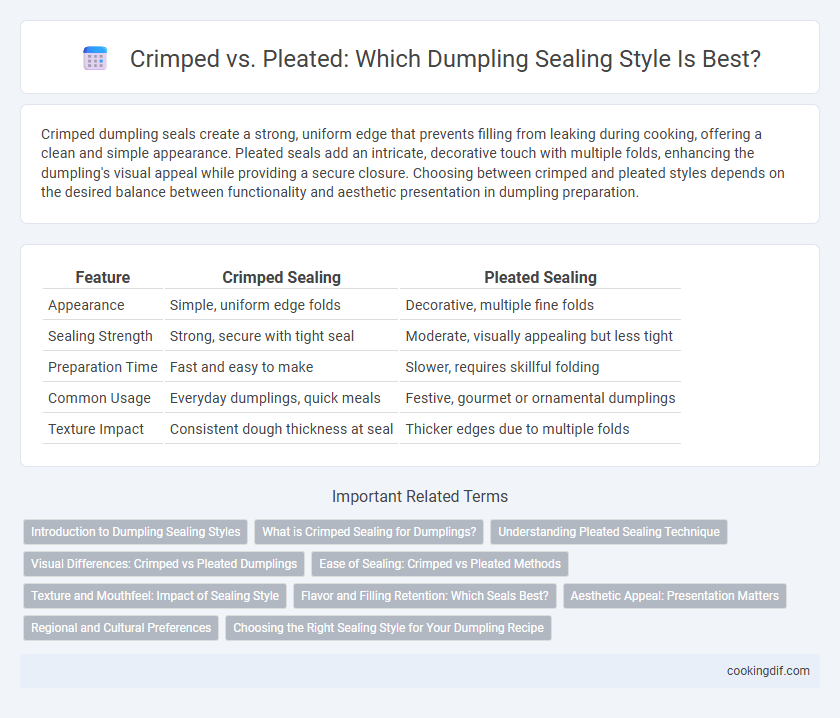Crimped dumpling seals create a strong, uniform edge that prevents filling from leaking during cooking, offering a clean and simple appearance. Pleated seals add an intricate, decorative touch with multiple folds, enhancing the dumpling's visual appeal while providing a secure closure. Choosing between crimped and pleated styles depends on the desired balance between functionality and aesthetic presentation in dumpling preparation.
Table of Comparison
| Feature | Crimped Sealing | Pleated Sealing |
|---|---|---|
| Appearance | Simple, uniform edge folds | Decorative, multiple fine folds |
| Sealing Strength | Strong, secure with tight seal | Moderate, visually appealing but less tight |
| Preparation Time | Fast and easy to make | Slower, requires skillful folding |
| Common Usage | Everyday dumplings, quick meals | Festive, gourmet or ornamental dumplings |
| Texture Impact | Consistent dough thickness at seal | Thicker edges due to multiple folds |
Introduction to Dumpling Sealing Styles
Dumpling sealing styles primarily include crimped and pleated methods, both ensuring the filling stays intact during cooking. Crimped sealing creates a simple, rustic edge by pressing the dough together with fingers or a fork, offering a quick and sturdy closure. Pleated sealing involves folding the dough into intricate, layered patterns, enhancing the dumpling's aesthetic appeal and providing a tight, decorative seal.
What is Crimped Sealing for Dumplings?
Crimped sealing for dumplings involves pinching the edges firmly together to create a tight, sealed edge that prevents filling from leaking during cooking. This method typically produces a simple, slightly ridged edge that ensures durability and a uniform seal. Crimped seals are ideal for retaining moisture and flavor inside dumplings, especially for boiling or steaming methods.
Understanding Pleated Sealing Technique
The pleated sealing technique for dumplings involves creating multiple folds along the edge to tightly seal the filling, enhancing both the appearance and structural integrity of the dumpling. This method ensures an even distribution of dough, preventing leakage and allowing for consistent cooking. Mastering pleating improves texture by providing a delicate, decorative finish that holds juices and flavors effectively during steaming or frying.
Visual Differences: Crimped vs Pleated Dumplings
Crimped dumplings feature evenly pinched edges that create a simple, sealed border with a uniform texture, while pleated dumplings display multiple intricate folds resembling tiny waves along the rim for an ornate appearance. Visually, crimped seals offer a clean, functional look ideal for casual meals, whereas pleated seals elevate presentation, often favored in gourmet or traditional settings. The difference in sealing style directly affects the dumpling's aesthetic appeal, highlighting craftsmanship through edge design.
Ease of Sealing: Crimped vs Pleated Methods
Crimped dumplings offer a straightforward and quick sealing process ideal for beginners, as the edges are simply pinched together creating a secure seal with minimal effort. Pleated dumplings require more skill and time, involving folding multiple pleats along the edge to enhance both the seal's strength and the dumpling's aesthetic appeal. While crimped seals are effective for preventing leaks, pleated seals provide added durability and a traditional appearance favored in many Asian cuisines.
Texture and Mouthfeel: Impact of Sealing Style
Crimped dumplings create a dense, firm edge that adds a slight chewiness, enhancing the overall texture with a satisfying bite. Pleated seals offer a softer, more delicate mouthfeel by distributing dough thickness evenly, allowing for tender, uniform cooking. The sealing style directly influences the dumpling's texture, affecting both the eating experience and how the filling interacts with the wrapper.
Flavor and Filling Retention: Which Seals Best?
Crimped dumpling seals create a tighter closure that minimizes juice leakage, preserving the filling's moisture and enhancing flavor intensity during cooking. Pleated seals, while visually appealing, tend to have slight gaps that can allow steam to escape, potentially leading to drier fillings and less concentrated taste. For optimal flavor retention and juicier dumplings, crimped sealing is generally preferred by chefs aiming for maximum filling preservation.
Aesthetic Appeal: Presentation Matters
Crimped dumpling edges offer a sleek, uniform appearance that highlights precision and craftsmanship, ideal for modern or minimalist presentations. Pleated dumplings showcase intricate folds that create a textured, artisanal look, enhancing visual interest and signaling handmade quality. Choosing between crimped or pleated sealing styles significantly influences the overall aesthetic appeal, making presentation a key factor in the dining experience.
Regional and Cultural Preferences
Crimped dumplings are favored in Northern Chinese cuisine, where a simple, robust seal highlights the hearty fillings typical of the region. Pleated dumplings, often associated with Southern Chinese traditions, showcase intricate folding techniques that reflect the area's emphasis on delicate texture and presentation. These sealing styles not only preserve the filling but also serve as cultural signatures, distinguishing regional dumpling varieties across Asia.
Choosing the Right Sealing Style for Your Dumpling Recipe
For dumpling sealing, crimped edges provide a rustic, sturdy seal ideal for thick, doughy wrappers and hearty fillings, preventing leaks during boiling or steaming. Pleated sealing offers a delicate, decorative finish that works best with thin wrappers and lighter fillings, enhancing presentation while maintaining integrity. Selecting the right sealing style depends on the texture of your dumpling dough and the moisture content of the filling to ensure optimal cooking results and aesthetic appeal.
Crimped vs Pleated for dumpling sealing style Infographic

 cookingdif.com
cookingdif.com